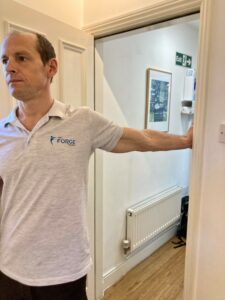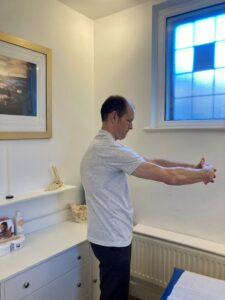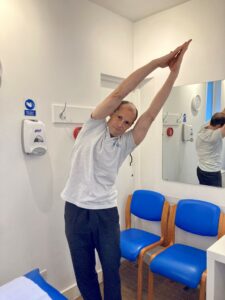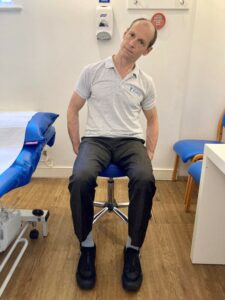We were never designed to sit in front of computer screens all day. We were born to move, and if you’re like most people, good sitting posture is not something that comes naturally. We are all guilty of slouching when sitting, and this often becomes more pronounced the longer we sit.
Generally, we only realise the need to address our postural habits when we start to experience discomfort. Back ache, neck ache, sore shoulders and headaches are the most common moments of epiphany. Sitting in a slumped position for long periods of time can cause muscle fatigue, particularly around the upper and lower back and some patients report experiencing numbness and tingling in their hands and arms after long periods at their desk.
Your chest muscles should be able expand as you breathe, allowing your lungs to fill up with air. However, when you’re slumped low in your seat, your chest muscles tighten, restricting the extent to which the lungs can expand. This can result in shallow, rapid breathing and a reduced flow of oxygen to the tissues and organs, including the brain. In addition to this restricted lung capacity, these slouched positions can also have an impact on your digestion. This is due to your internal organs being compressed. All of which can contribute to lower energy and mood.
There are a few easy steps I recommend to my patients to help improve their postural habits and reverse the negative spiral of postural pain and dysfunction:
- Use a standing desk – you are unlikely to want to stand all day but there are many options for standing desks or units on desks which are easily adjustable. These allow you to alternate between sitting and standing. This will help your lower back and reduce your tendency to slouch.
- Take movement breaks – if you can’t get a standing desk, take more frequent breaks to get up and move around, even if this is just for a few seconds it will break the sitting pattern.
- Replace your chair with an exercise ball – a cheaper option which can make it more difficult to slouch by forcing deep postural stabilizing muscles to activate. You can also try some pelvic and lower back exercises while working to keep more mobility and suppleness. Just don’t forget, you can’t lean back anymore!
- Keep your ears, shoulders and hips aligned – an easy trick to check your head isn’t protruding too far forward is to just keep the head in line with the shoulders and in turn in line with the hips
- Uncross your legs – it’s just so comfortable to sit with crossed legs. But this can cause imbalance in the pelvis, a strain on the deep hip muscles and generally poor circulation into the legs. Keep both feet flat on the floor.
- Try some stretches – those tight muscles can get some relief with periodic stretching throughout the day, these can take mere minutes to do and will really help. Below are a few stretches to try.
Doorway stretch – hold a doorway with thumb pointing up and turn away.

Upper back stretch – reach out straight in front pull hands apart without letting go.

Pencil stretch – reach overhead with both arms and tilt side to side.

Neck stretch – sit on your hands, palm facing upward. Tilt to one side and hold, repeat the other side. Then look left and right a few times.

If you are struggling with desk or work-related aches and pains, or would like more advice on your work set up, please get in touch. Contact us on 02083326184 to book an appointment or alternatively you can book online.
